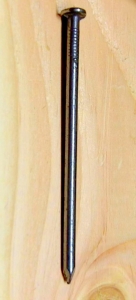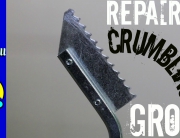How to Choose the Right Nail for Your Project. Choosing which nail to use on your wood project can be confusing, and nails aren’t limited to wood-to-wood connections, but are also used for fastening to materials such as concrete, masonry or metal. See Jane Drill hopes to shed a little light on the question of which nail to use for which project. See our easy guide below:
Some Basic Nail Types
Common Nail: Common nails have large nail heads, a smooth thick shank and are often used for framing and general construction. Their large heads give superior holding ability, and make them easier to drive.
Box Nail: Box nails have large flat heads and a thinner shank than common nails. Their thinner nail shaft makes them easier to drive when nailing by hand.
Finish Nail: Finish nails have very small heads thin shanks, and can be easily driven below the surface, where they can be hidden with wood putty when a less conspicuous presence is desired, such as for crown moulding and cabinets.
Casing Nail: Think of a casing nail as being a heavy duty finish nail. They have a conical head, a thin shank and are driven flush.
Sheathing Nail: Sheathing nails have flat heads and ringed shanks. The ringed shank offers increased withdrawal resistance, resulting in superior holding power. Sheathing nails are ideal for floor and wall sheathing.
Masonry Nail: Masonry nails have flat heads, fluted shanks are made of hardened steel. This grooved thread style gives them both superior holding power in concrete block and the ability to cut masonry and minimize cracks.
Stainless Steel Nail: Stainless steel nails are a better choice over galvanized nails when used in a marine environment or when building a structure in severe or very corrosive conditions. In addition, stainless steel nails are the recommended choice when working with natural cedar and redwood.
Nail Coatings:
Galvanized Nails: Galvanizing gives a chalky gray appearance. These nails are ideal for exterior use and where moisture is a concern. In addition, galvanized nails are recommended when using pressure-treated wood. These nails are covered with a layer of zinc which makes them corrosion-resistant. See Jane Drill recommends using the “hot-dipped” type of galvanized nail, rather than the “electroplated” or “hot-galvanized” types, as the hot-dipped are most durable of the three types.
Vinyl/Resin Coated Nail: Vinyl coated nails usually have a yellowish metallic appearance. Their coating makes them easier to drive, as the coating melts when driven, providing lubrication that reduces friction. In addition, once the melted vinyl cools, it hardens and increases the nail’s holding power.
Nail Length: Nail length is identified by numbers from 4 to 60, followed by the letter d which stands for penny. In most applications the nail should be 2-3 times longer than the lumber being held. Always nail the lighter lumber piece to the heavier piece.
2d = 1″
3d = 1-1/4″
4d = 1-1/2″
5d = 1-3/4″
6d = 2″
7d = 2-1/4″
8d = 2-1/2″
9d = 2-3/4″
10d = 3″
12d = 3-1/4″
16d = 3-1/2″
20d = 4″
30d = 4-1/2″
40d = 5″
50d = 5-1/2″
60d = 6″
BY SEE JANE DRILL, Copyright 2015, All Rights Reserved








Leave A Comment